There's an exhibition of Artemisia Gentileschi on in Milan, but who wants to pay Milanese prices for a hotel? We're basing in Orta instead, with time for the holy statues.
Orta San Giulio and the Sacri Monti, autumn 2011
You may not find this terribly rewarding unless you're included here, so this is a good time for casual and random browsers to turn back before they get too caught up in the sweep and majesty of the proceedings and can't let go.

20 November 2011: The village of Orta San Giulio sits on a small promontory stuck out the east side of the Lago di Orta (also Lago d'Orta) in the Piedmont region, just west of Lago Maggiore. The Villa Crespi, built in the "middle-eastern style" by a successful merchant in 1879, entertained royalty and celebrities through the 1930s and was converted into a luxury hotel in the 1980s, and still guards the entrance to the only road out onto the promontory.

Orta is a lovely town of a thousand-plus residents in a fantastic mountain setting, and it's got a lively small-scale tourist trade in the summers. We're here in mid-November, though, so the tourist train looks despondent. This is a Dotto Train "Muson River 1894", the Euro 5 model, probably the most common road-train model in Europe, very cute and very serviceable. But sometimes empty.

We've driven over the Simplon Pass and down past Domodossola in Italy, turning west at Gravellina Toce near Lago Maggiore and over to Omegna at the head of the Lago di Orta and down the lake shore (4 hours from near Geneva). Now we've left our VW, "Friedrich Schiller", in the empty carpark at the neck of the Orta promontory and, until we were distracted, we were about to walk a few hundred meters round the coast road to the Casa sul Lago self-catering flats. (One of the local restaurants specializes in donkey steaks, so this fellow may have joined his ancestors by now.)

The plan of Orta San Giulio and the island

The Casa sul Lago in late afternoon (dragging our little carry-on bags behind us)

We're settling in to the top-floor flat, called "Cinqueterre", with the famous Isole di San Giulio peeking in the window.

As the streetlights come on, we're walking farther round the coast road to see what's for dinner.

But first a visit to the wine and cheese shop for some groceries for the flat
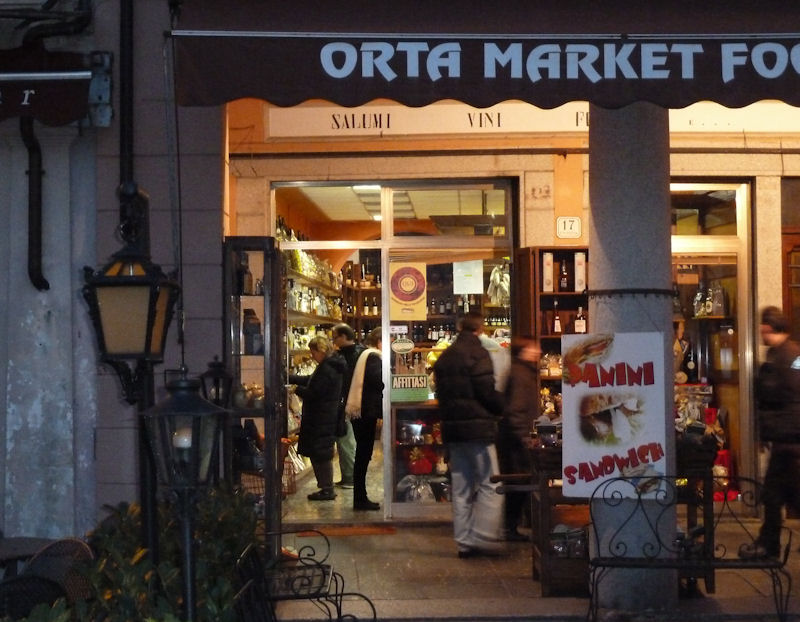
And then a visit to the wine and salami shop for some more groceries for the flat.

And then a visit to check in at "Hello Orta", the "welcome point" and seat of the company that owns some of the accommodations in town, including ours.
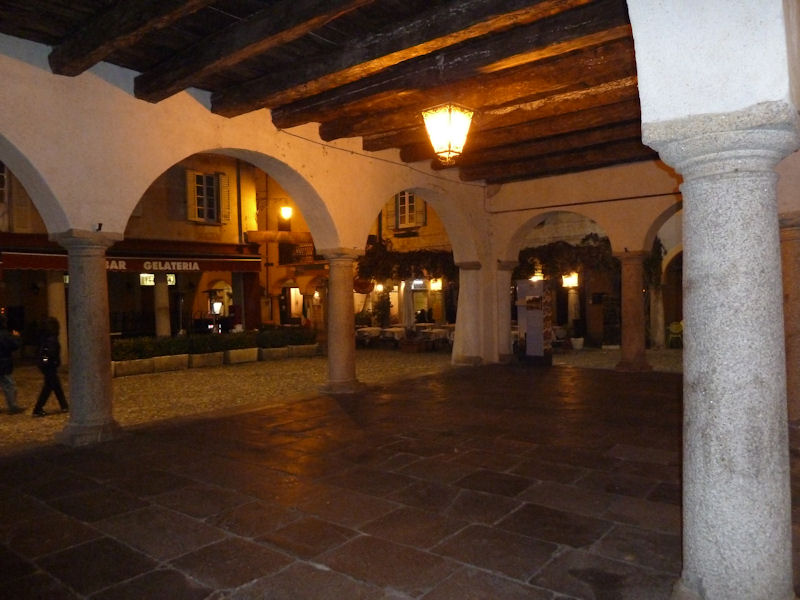
The inside of the Palazzo della Comunità, the 16th century city hall with a ground floor that looks more like the old vegetable market. On the far side left, the Venus restaurant was excellent ("No Pizza!" says their sign), whereas the Hotel Leon d'Oro in the centre background was okay but not very friendly. (I liked the Pizzeria La Campana best, more on that later.)

A fuzzy night view of the Palazzo della Comunità (not to be confused with a view of Fuzzy Knight, 1901-1976). Properly, it's a 'broletto', a characteristic administrative building of the medieval commune period featuring a ground-floor arcade, in which the voting population could assemble for deliberations, and city administrative offices upstairs.

Breaking out the groceries in the Cinqueterre rooms. The location was perfect and the rooms commodious, but there were odd little negligencies -- like nearly no lights; a kitchen with dishes but no pots or pans; WiFi only on the ground floor; a gas stove with a box of matches with only one match in the box; that sort of thing. Never mind. Tomorrow is for religion.
The Sacro Monte di Orta

The tradition of the Sacri Monti began in about 1490, when the Rector of the Palestinian holy sites, Bernardino Caimi, a good friend of Ludovico "Il Moro" Sforza, effectively the Duke of Milan at the time, came home with a plan to build a replica of Holy Land tourist destinations on a small mountaintop in Varallo, just over the mountains west of Orta.

The whole idea was to tell the biblical or saints' stories in terracotta statues and frescoes to grab the imaginations of a largely illiterate populace with lively recreations, often with their friends and family used as the sculptors' models.

The idea caught on, and Sacri Monti were built in several other places, and one was begun on the hilltop at the centre of the peninsula of Orta, about 40 or 50 meters above the town, in about 1590. This one is devoted to the life of St Francis of Assisi. Small chapels were added regularly, in Orta's case to the end of the 18th century, and there are presently 20 of them here, with a marked itinerary to lead pilgrims from one tableau to the next.

Life was not easy for St Francis, and the visitors get to share his troubles with him.
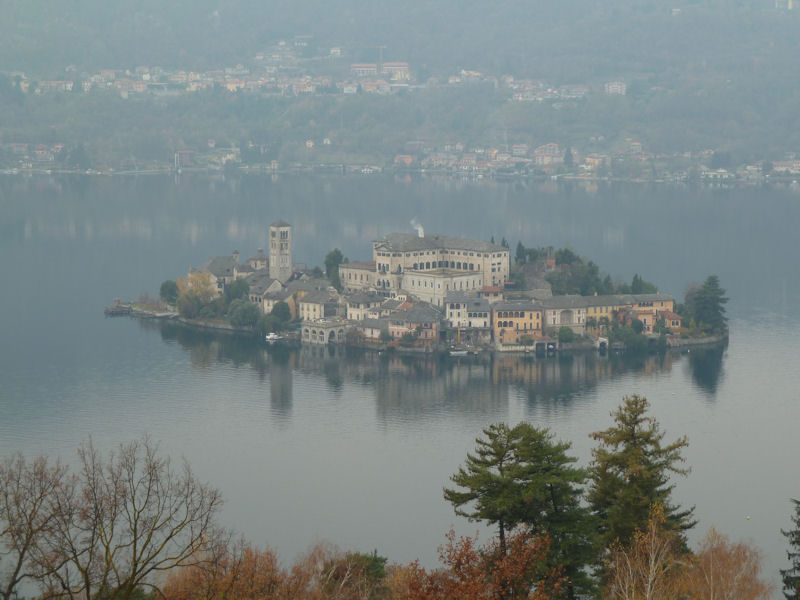
The Isola di San Giulio below, from the Sacro Monte

Dominated now by a convent, apparently, and some restaurants, but with an interesting history. We'll be able to get some sunny-day photos later.

We wandering about and not really following the itinerary (the little red hand on the wall), from the simple, unadorned works of the 16th and 17th centuries to the theatrical, perhaps bombastic extravaganzas of the 18th.

The "Sacri Monti of Piedmont and Lombardy" were designated as a single UNESCO World Heritage cultural site in 2003: "The nine Sacri Monti (Sacred Mountains) of northern Italy are groups of chapels and other architectural features created in the late 16th and 17th centuries and dedicated to different aspects of the Christian faith. In addition to their symbolic spiritual meaning, they are of great beauty by virtue of the skill with which they have been integrated into the surrounding natural landscape of hills, forests and lakes."

As the World Heritage Centre suggests, part of the effect of the itinerary comes also from the careful landscaping and settings, which among other things probably provided the pilgrims, not only an uplifting spiritual experience, but also a day out in the park.
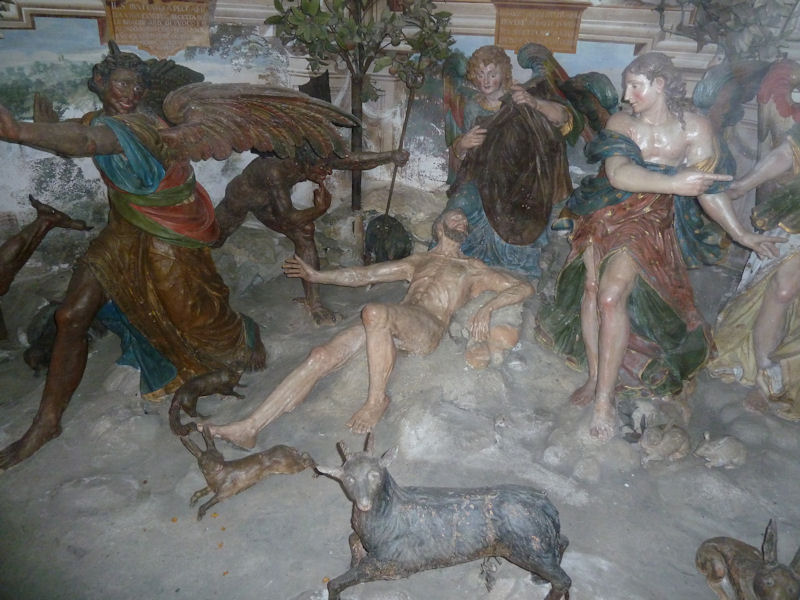
St Francis in the celestial tug of war

Apparently, St Francis asked to be led around "naked" (luckily for us, not exactly naked), in order to show his "humility". St Francis definitely considered himself the hero of his own story.

Though sometimes the bystanders got in the way

I think that this is the one that was half-finished when Napoleon came into the area militarily and said "no more superstitious religious stuff", and that was that.
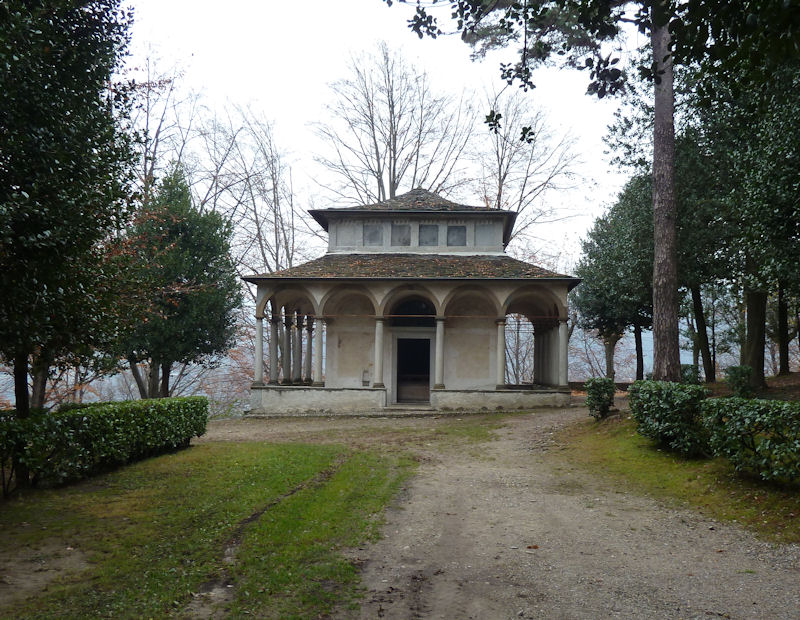
World Heritage continues: "The phenomenon of sacri monti ("sacred mountains") began at the turn of the 15th and 16th centuries with the aim of creating in Europe places of prayer as alternative to the Holy Places in Jerusalem and Palestine, access to which was becoming more difficult for pilgrims owing to the rapid expansion of Muslim culture. . . . Within a few years, especially after the Council of Trent in 1535, this model, and in particular that of Varallo, built around 1480, were used for another purpose . . . to combat the influence of Protestant 'Reform' by promoting the creation of more Sacri Monti as concrete expressions of their preaching." [Never mind that the Council of Trent ran from 1545 to 1563.]

A lot of the best chapels look more like big tombs.
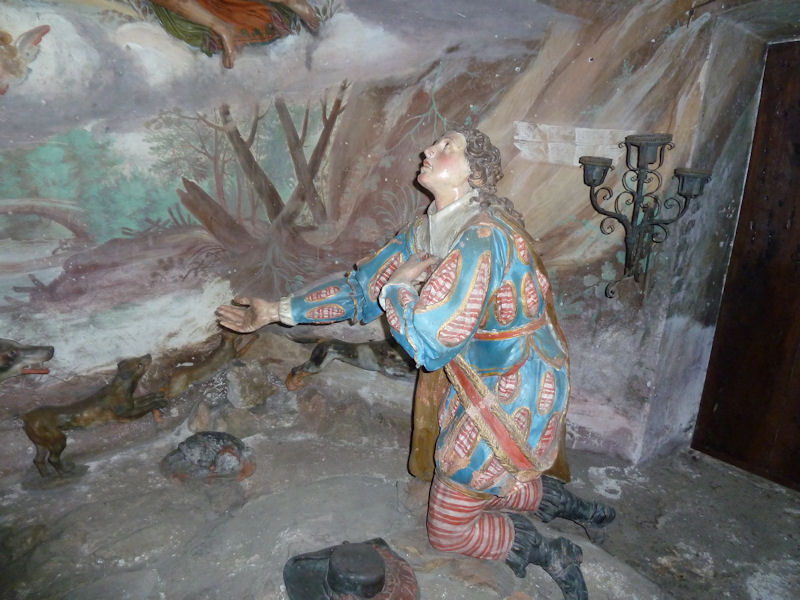
St Francis, like St Augustine (and like every Southern Baptist preacher I've ever met), was a hell-raiser until Jesus came into his heart. Love the pyjama pants.

Looking down at Orta village from the Sacred Mountain
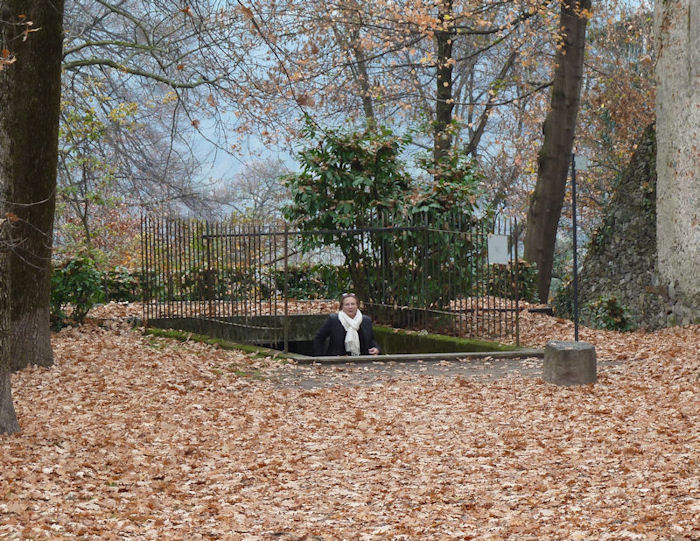
Kristin rising from the crypt
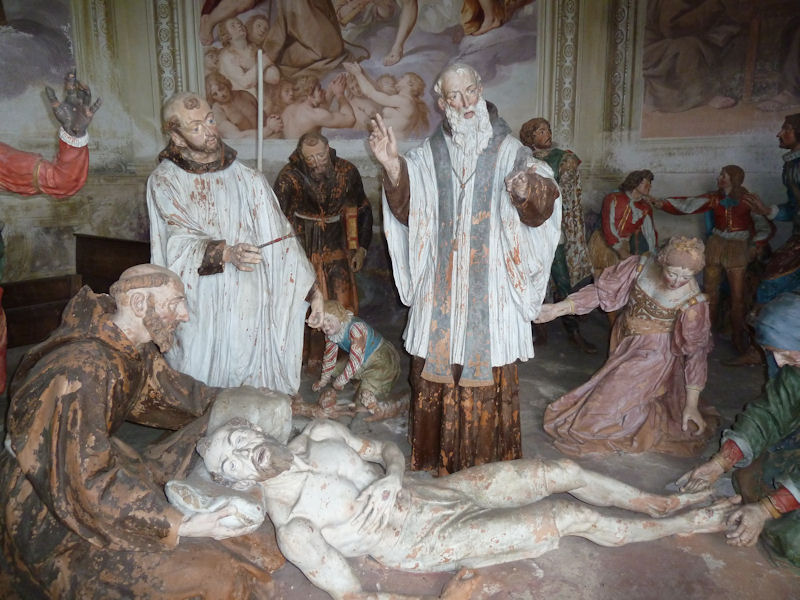
St Francis headed for the crypt. We're at the end of the itinerary, and we're so charged up with religious terracotta that we need to go back to the source . . . Varallo.
Sacro Monte di Varallo

Varallo's an hour's drive over the mountains on the far side of Lake Orta, and we're about to enter the replica Holy Land. This one's got 45 chapels/displays and its own basilica.

The Sacro Monte of Varallo, perhaps 120 metres above the town, starts with an Adam & Eve but then carries on with stories from the Life of Christ in gospel and legend.

This is a small square just next to the main one, with the basilica, in the recreated "City of Jerusalem". As at Orta, the oldest displays are fairly rudimentary and pretty tatty, whereas the latest ones leap out more and grab the visitors by the histrionic throat.

Jesus, presumably, being led before high priests or Pontius Pilate or somebody. That's chicken wire around the outside.

A biblical scene, doubtless instantly recognized by enthusiasts. That's Jesus in the centre, we infer, already the worse for wear.
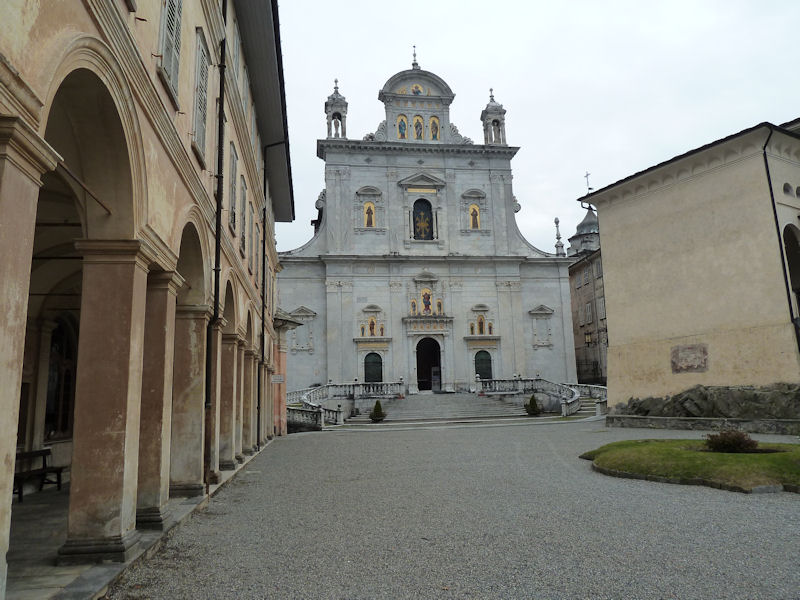
The basilica dominates the main square of the "City of Jerusalem".

-- Watch, kid. This is history being made before your eyes.

The church here seems to be another home base for the Friends of Padre Pio -- Padre Pio (1887-1968) evidently helped people, and had stigmata and what not, so when people survive car crashes they bring along pictures to stick up on the wall in gratitude for his . . . help, or intercession, or something.
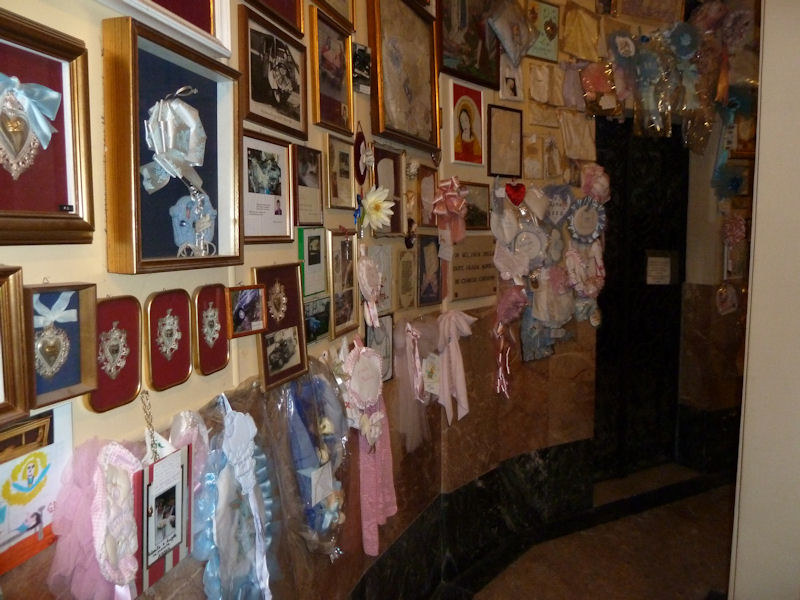
Also, when kids get born alive, we get photos and mementos stuck up everywhere, amongst the car crashes. The little sign in the centre asks people to bring their live-birth mementos to the main desk, don't just them stick them up anywhere themselves.

What's especially touching is that all of these heartfelt keepsakes are pinned all round the tiny corridor behind Jesus's mother, Mary, or Madonna.
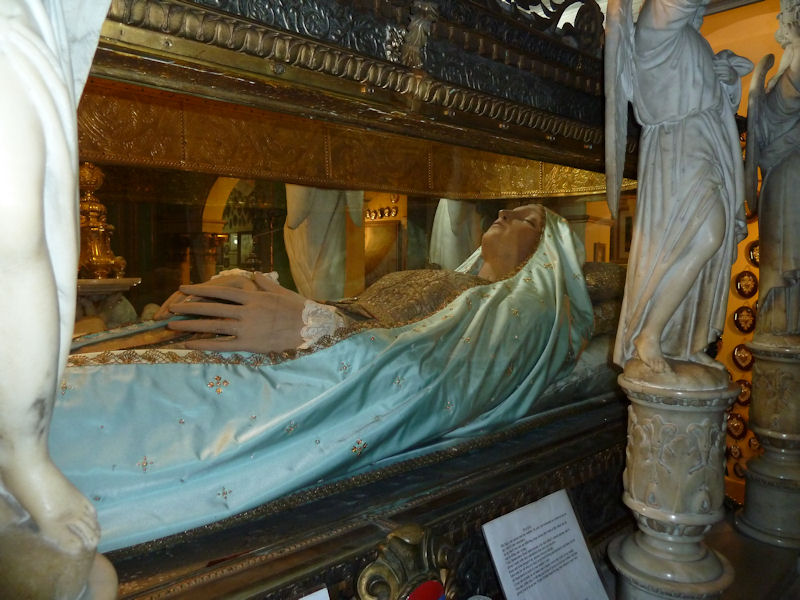
This is not actually the Virgin Mary, or Madonna, herself -- this, it says, is a "wooden statue brought in from Orient [sic] by Brother Bernardino Caimi, inventor of the Sacred Mount Plan, at the end of the XV century".

That's apparently the picnic spot. Really.
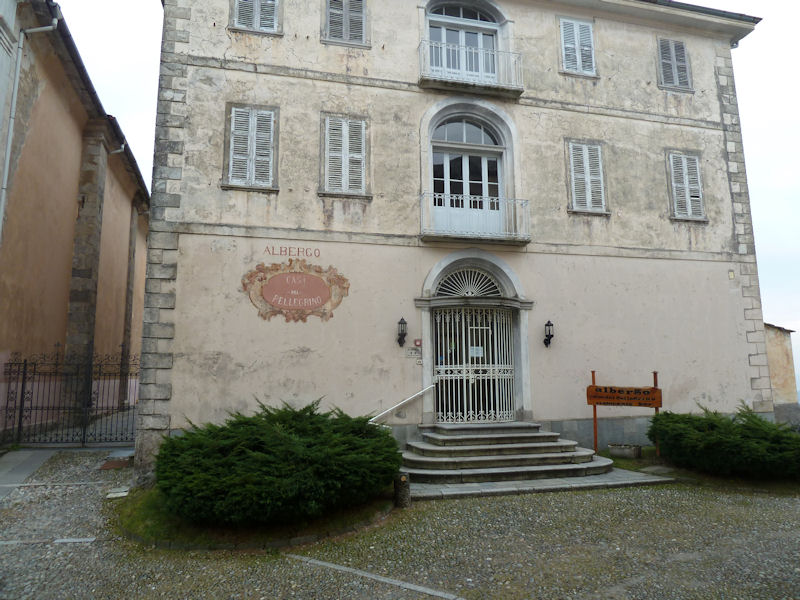
The House of the Pilgrim -- low-cost accommodations for the faithful (that's actually a chain of hotels)

The basilica

Varallo and the river Sesia. No way we're going back over those mountains in the dark -- we'll drive out that valley and see where we end up. (Not too bad: Grignasco, Romangnano Sesia, Borgomanero, Gozzano, and Bob's your uncle.)

Looking down into Varallo -- and that's not the Old Town.

More old Varallo. There's a funiculaire up to the Sacred Mountain, that's good. The pilgrims don't have to walk all the way up on their knees or anything.

Awww, there's Mary and Baby Jesus -- he seems upset about something, what could it be? (One of the really horrible things about these displays in Varallo is that most of the main characters have ratty old real hair on, which has had to be replaced every 100 years or so.)

Oh Jesus! It's the Circumciser General!
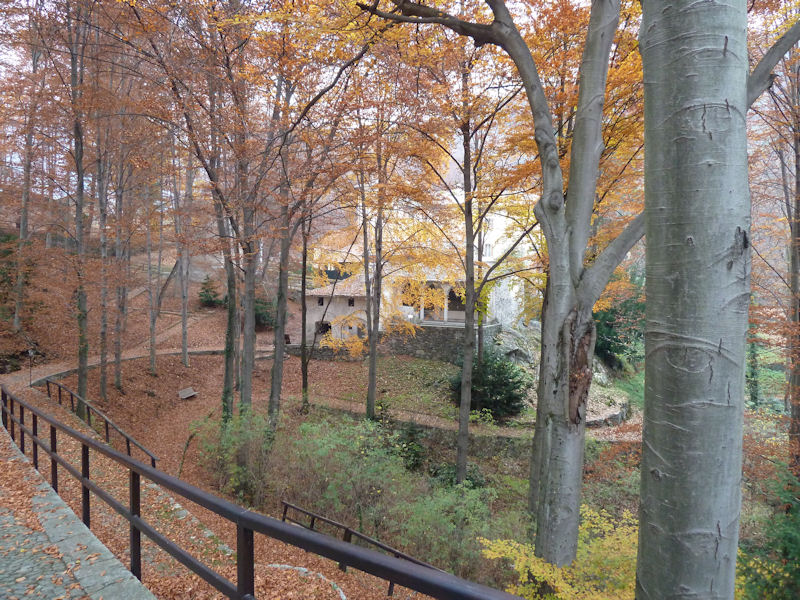
It's time to leave the Sacro Monte of Varallo.
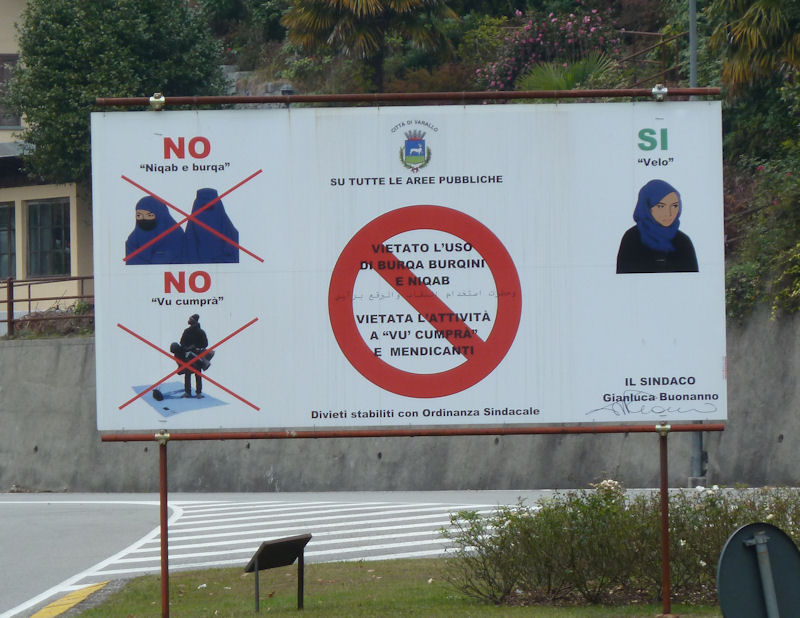
Varallo is a No-Burqa town. No niqabs either. No beggars. And no "Vu' cumprá", a dialectical attempt to capture the "You wanna buy?" of subsaharan street sellers.

Back in Orta for dinner. Tomorrow -- ART.


See also the Sacro Monte di Belmonte, February 2019